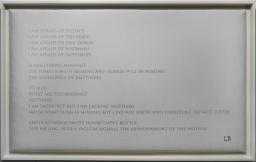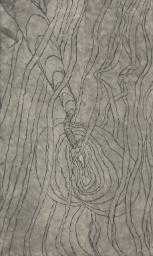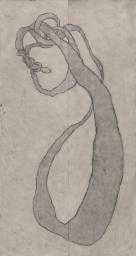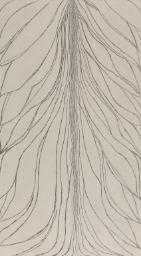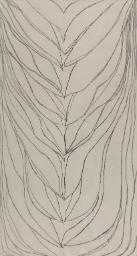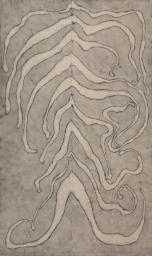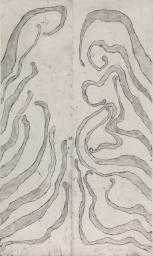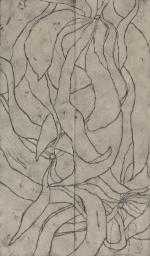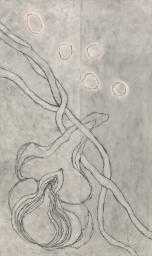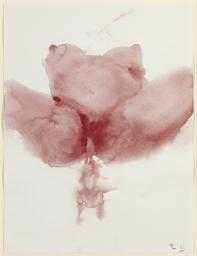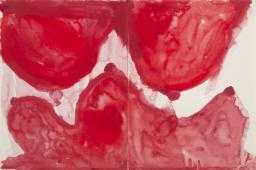
Not on display
- Artist
- Louise Bourgeois 1911–2010
- Medium
- 20 etchings with watercolour, pencil and gouache on paper
- Dimensions
- Image, each: 380 × 910 mm
frame, each: 478 × 1006 × 40 mm - Collection
- ARTIST ROOMS
Tate and National Galleries of Scotland. Lent by Artist Rooms Foundation 2013
On long term loan - Reference
- AL00345
Summary
10 am is When You Come to Me is a multipart work, consisting of twenty hand-painted sheets of musical score paper depicting the hands of the artist and those of her assistant Jerry Gorovoy. The artist’s hands are discerned by her wedding ring. Bourgeois’s and Gorovoy’s hands, painted in various shades of red and pink or outlined in black, adopt a number of poses. Sometimes only Bourgeois or Gorovoy’s hands are represented, at others they reach across toward each other or meet. The etching in the top left corner depicts a clock, with hands set at 10 am. The hands of the clock are composed of a nude male and female figure, with the nude male in the place of the minute hand and the nude female in the place of the hour hand. Across the image of the clock the title of the work, ‘10AM is when you come to me’, is written in red paint. Each sheet is framed individually and hung in a grid with five rows of four frames each. Bourgeois produced this work in 2006. The artist made ten unique versions, including a larger-scale one featuring forty sheets.
Gorovoy was a frequent model for other works by Bourgeois that feature hands. For instance the sculpture The Welcoming Hands 1996 (Jardin des Tuileries, Paris), which depicts the artist’s hands clutching Gorovoy’s in bronze. Bourgeois met Gorovoy in the late 1970s; he was her assistant, close friend and confidant for over thirty years. She remarked of him: ‘When you are at the bottom of the well, you look around and say, who is going to get me out? In this case it is Jerry who comes and he presents a rope, and I hook myself on the rope and he pulls me out.’ (Quoted in Morris 2007, p.150.) The depiction of hands and arms reaching across the expanses of paper in this work parallels Bourgeois’s description of being pulled out of a well, suggesting that Gorovoy’s presence remedied the artist’s feeling of isolation. The title of the work, 10 am is When You Come to Me, is a reference to the time of the morning when Gorovoy would arrive at Bourgeois’s studio or home to begin their working day together and thus reflects the reliability and familiarity of their daily routine. Indeed because the work was made by drawing around their hands, it could also be seen as a direct record or index of their shared time in the studio. Yet while it is possible to read a personal narrative into this work, the interplay of the two sets of hands also reflects the nature of close friendships in general. This theme appears differently in other works by Bourgeois that use the motif of the hand to symbolise dependency and support, such Nature Study 1986 (Tate AL00228).
The artist’s use of red in 10 am is When You Come to Me is characteristic of her work on paper. Bourgeois said: ‘Red is an affirmation at any cost – regardless of the dangers in fighting – of contradiction, of aggression. It’s symbolic of the intensity of the emotions involved.’ (Quoted in Askew and d’Offay 2013, p.85.) The colour red here might symbolise the emotional intensity and passion present in this intimate friendship as well as the warmth, both literal and figurative, of two bodies interacting. The sequence of different poses in this work also demonstrates the quotidian quality of Bourgeois and Gorovoy’s relationship. The distinct composition of each sheet alludes to moments of disconnection as well as connection, perhaps suggesting another reading of the work as a map of their working relationship and the varied successes of artist and assistant to realise a work. Indeed the process of making is highlighted in the splatters and impressions of paint marking the paper.
The use of musical score paper further emphasises the rhythm of Bourgeois and Gorovoy’s relationship, although the absence of notes suggests the unscripted openness of their interaction. When the full extent of the grid is visible, the staves become almost imperceptible and the multiple gestures read more like choreography. In this way the work elevates the habitual gestures of touching, reaching and holding into a dance.
Further reading
Paul Gardner, Louise Bourgeois: Universe Series on Women Artists, New York 1994.
Francis Morris (ed.), Louise Bourgeois, exhibition catalogue, Tate Modern, London 2007, reproduced (larger version) p.151.
Lucy Askew and Anthony d’Offay, Louise Bourgeois: A Woman Without Secrets, exhibition catalogue, National Galleries of Scotland, Edinburgh 2013, p.85, reproduced pp.19, 22–3, 60–1.
Allan Madden
The University of Edinburgh
November 2014
The University of Edinburgh is a research partner of ARTIST ROOMS.
Does this text contain inaccurate information or language that you feel we should improve or change? We would like to hear from you.
Display caption
These prints show drawings of Bourgeois’s hands and those of Jerry Gorovoy, her assistant for over thirty years. The title refers to the daily time of Gorovoy’s arrival at Bourgeois’s studio or house. She was particularly fascinated by the physical contrast between her small hands and the large hands of Jerry Gorovoy.
Gallery label, October 2016
Does this text contain inaccurate information or language that you feel we should improve or change? We would like to hear from you.
You might like
-
Louise Bourgeois I Am Afraid
2009 -
Louise Bourgeois Femme
2007 -
Louise Bourgeois À L’Infini
2008–9 -
Louise Bourgeois The Nest
2009 -
Louise Bourgeois Turning Inwards
2008 -
Louise Bourgeois The Smell of Eucalyptus (#1)
2006 -
Louise Bourgeois The Smell of Eucalyptus (#2)
2006 -
Louise Bourgeois Are You In Orbit? (#1)
2007 -
Louise Bourgeois Are You In Orbit? (#2)
2007 -
Louise Bourgeois Les Fleurs
2007 -
Louise Bourgeois Love and Kisses
2007 -
Louise Bourgeois My Inner Life
2008 -
Louise Bourgeois The Birth
2007 -
Louise Bourgeois The Family
2008 -
Louise Bourgeois The Friendly Landscape
2008

